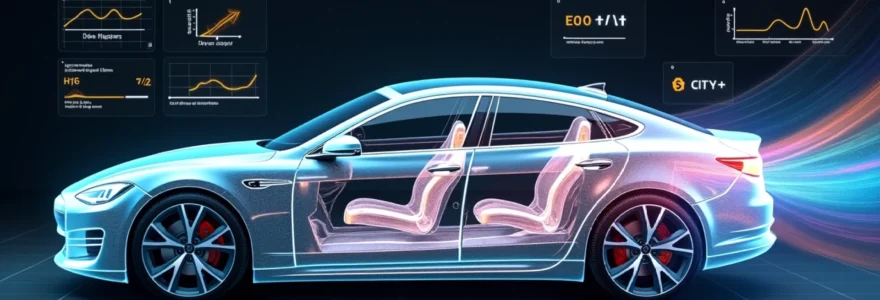Fuel efficiency is a critical factor in the automotive industry, impacting both consumer choices and environmental sustainability. As vehicle manufacturers strive to meet increasingly stringent fuel economy standards, accurate measurement of miles per gallon (MPG) has become more important than ever. Understanding the intricacies of fuel efficiency testing not only helps consumers make informed decisions but also drives innovation in the automotive sector. This comprehensive guide delves into the sophisticated methods used to measure and improve fuel economy, from standardized laboratory procedures to real-world performance evaluations.
Standardized fuel efficiency testing protocols
The foundation of fuel efficiency measurement lies in standardized testing protocols. These procedures ensure consistency and comparability across different vehicle models and manufacturers. Standardized tests simulate various driving conditions to provide a comprehensive picture of a vehicle's fuel consumption patterns.
One of the most widely recognized testing standards is the Corporate Average Fuel Economy (CAFE) program in the United States. CAFE standards set fuel efficiency targets that automakers must meet across their fleet of vehicles. These standards have been instrumental in driving improvements in fuel economy over the past several decades.
Globally, different regions have adopted their own testing protocols. For instance, the European Union uses the Worldwide Harmonised Light Vehicle Test Procedure (WLTP), which replaced the older New European Driving Cycle (NEDC) in 2017. The WLTP aims to provide more realistic fuel consumption figures by incorporating a wider range of driving scenarios.
Standardized testing protocols are essential for creating a level playing field in the automotive industry and providing consumers with reliable fuel efficiency information.
EPA dynamometer testing procedures
The U.S. Environmental Protection Agency (EPA) has developed sophisticated dynamometer testing procedures to measure fuel efficiency under controlled laboratory conditions. These tests form the basis for the fuel economy ratings displayed on new vehicle window stickers and used in CAFE compliance calculations.
City driving cycle simulation
The EPA's city driving cycle, known as the Federal Test Procedure (FTP), simulates urban driving conditions. This test includes frequent stops, starts, and low-speed operation, reflecting typical city driving patterns. The FTP cycle runs for approximately 31 minutes and covers a distance of 11 miles, with an average speed of 21.2 mph.
During the city cycle, the vehicle undergoes a cold start, where the engine begins at ambient temperature. This phase is crucial for measuring emissions and fuel consumption during the warm-up period, which is typically when vehicles are least efficient.
Highway driving cycle analysis
Complementing the city cycle is the Highway Fuel Economy Test (HWFET). This test simulates highway driving conditions with higher speeds and fewer stops. The HWFET cycle lasts about 13 minutes, covering a distance of 10.26 miles at an average speed of 48.3 mph.
The highway test begins with a warmed-up engine, focusing on steady-state fuel consumption at higher speeds. This test is particularly important for evaluating the efficiency of aerodynamic designs and engine performance at sustained high speeds.
CAFE standards integration
The results from both city and highway tests are combined to calculate the overall fuel economy rating used for CAFE compliance. The EPA applies a formula that weights the city cycle at 55% and the highway cycle at 45%, reflecting the average distribution of urban and highway driving in the United States.
CAFE standards have become increasingly stringent over time, pushing manufacturers to innovate and improve fuel efficiency across their vehicle lineups. The integration of these standards with standardized testing procedures ensures that improvements in laboratory performance translate to real-world benefits for consumers and the environment.
5-cycle test method for Real-World accuracy
Recognizing that the traditional two-cycle test (city and highway) often resulted in overly optimistic fuel economy estimates, the EPA introduced the 5-cycle test method in 2008. This expanded testing regimen includes additional cycles that account for more varied driving conditions:
- High-speed driving (up to 80 mph)
- Rapid acceleration and braking
- Use of air conditioning
- Cold temperature operation
- Short trips with frequent stops
The 5-cycle method provides a more comprehensive evaluation of fuel efficiency, resulting in MPG ratings that more closely align with real-world fuel consumption. This enhanced accuracy helps consumers make more informed decisions when comparing vehicle fuel economy.
On-road performance evaluation techniques
While laboratory tests provide valuable standardized data, on-road performance evaluations offer insights into real-world fuel efficiency. These techniques complement dynamometer testing by accounting for variables that are difficult to simulate in a controlled environment.
Coast-down testing for aerodynamic drag
Coast-down testing is a critical procedure for measuring a vehicle's aerodynamic drag and rolling resistance. In this test, a vehicle is accelerated to a specific speed and then allowed to coast to a lower speed or a complete stop. By analyzing the deceleration rate, engineers can calculate the forces acting on the vehicle.
The results of coast-down tests are used to calibrate dynamometers for more accurate laboratory testing. Additionally, these tests help manufacturers optimize vehicle designs for reduced drag, which can significantly impact fuel efficiency at highway speeds.
Constant speed fuel consumption tests
Constant speed tests involve driving a vehicle at steady speeds for extended periods to measure fuel consumption under stable conditions. These tests are typically conducted on test tracks or closed roads and can reveal how a vehicle performs at various speeds.
Engineers use constant speed tests to:
- Identify the most fuel-efficient cruising speed
- Evaluate the effectiveness of transmission gearing
- Assess the impact of aerodynamic modifications
- Fine-tune engine management systems for optimal efficiency
Gps-tracked route replication
GPS-tracked route replication allows engineers to test vehicles on predefined routes that represent typical driving patterns. By using GPS data to precisely replicate speed profiles and route characteristics, manufacturers can evaluate fuel efficiency under consistent, real-world conditions.
This technique is particularly valuable for:
- Comparing different vehicle models on the same route
- Assessing the impact of traffic patterns on fuel consumption
- Evaluating the effectiveness of start-stop systems and regenerative braking in hybrid vehicles
On-road testing is essential for validating laboratory results and ensuring that fuel efficiency improvements translate to real-world benefits for consumers.
Advanced fuel flow measurement systems
Accurate measurement of fuel flow is crucial for determining fuel efficiency. Advanced fuel flow measurement systems provide precise data on fuel consumption during testing procedures.
Gravimetric fuel metering devices
Gravimetric fuel metering devices measure fuel consumption by weight, offering high precision and reliability. These systems use load cells to continuously monitor the weight of the fuel tank, providing real-time data on fuel usage.
The advantages of gravimetric systems include:
- Immunity to fuel temperature variations
- High accuracy across a wide range of flow rates
- Ability to measure instantaneous fuel consumption
Coriolis flow meters for precision
Coriolis flow meters leverage the Coriolis effect to measure mass flow directly, offering exceptional accuracy for fuel consumption measurement. These meters are particularly useful for testing high-performance engines and alternative fuel vehicles.
Key features of Coriolis flow meters include:
- Direct mass flow measurement without the need for temperature or pressure compensation
- High accuracy even with pulsating flows
- Ability to measure fuel density in addition to flow rate
OBD-II data logging and analysis
On-Board Diagnostics II (OBD-II) systems provide a wealth of real-time data that can be used to analyze fuel efficiency. By logging and analyzing OBD-II data, researchers can gain insights into fuel consumption patterns under various driving conditions.
OBD-II data logging offers several advantages:
- Non-intrusive measurement without modifying the vehicle's fuel system
- Ability to capture a wide range of vehicle parameters simultaneously
- Easy integration with GPS data for route-specific analysis
Vehicle-specific factors affecting MPG
While standardized tests provide a baseline for comparison, numerous vehicle-specific factors can significantly impact real-world fuel efficiency. Understanding these factors is crucial for both manufacturers and consumers seeking to optimize MPG performance.
Key factors influencing fuel efficiency include:
- Vehicle weight and aerodynamics
- Engine size and technology (e.g., turbocharging, direct injection)
- Transmission type and gearing
- Tire rolling resistance
- Auxiliary power demands (e.g., air conditioning, electronics)
Manufacturers continuously refine these elements to improve overall fuel economy. For instance, lightweight materials such as aluminum and carbon fiber are increasingly used to reduce vehicle weight without compromising safety or performance.
Advanced technologies like cylinder deactivation and start-stop systems have also made significant contributions to improving fuel efficiency, particularly in urban driving scenarios. These innovations highlight the importance of considering both mechanical and electronic factors in fuel economy optimization.
Data analysis and MPG calculation methods
The final step in measuring fuel efficiency involves sophisticated data analysis and calculation methods. These techniques ensure that raw test data is accurately translated into meaningful MPG figures.
Carbon balance equation for fuel consumption
The carbon balance method is a widely used technique for calculating fuel consumption based on exhaust emissions. This method relies on the principle that the carbon in the fuel must be equal to the carbon in the exhaust gases.
The carbon balance equation takes into account:
- Carbon dioxide (CO2) emissions
- Carbon monoxide (CO) emissions
- Unburned hydrocarbons in the exhaust
By measuring these components in the exhaust gas, researchers can calculate the amount of fuel consumed with high accuracy, even without direct fuel flow measurement.
Statistical regression models for MPG prediction
Statistical regression models are used to predict fuel efficiency based on various vehicle and environmental parameters. These models analyze large datasets from multiple tests to identify correlations between different factors and fuel consumption.
Regression models can account for:
- Vehicle speed and acceleration profiles
- Road grade and surface conditions
- Ambient temperature and humidity
- Driver behavior patterns
By incorporating these variables, statistical models can provide more accurate predictions of real-world fuel economy across a range of driving conditions.
Machine learning algorithms in efficiency forecasting
The advent of machine learning has revolutionized fuel efficiency forecasting. Advanced algorithms can process vast amounts of data from various sources, including on-road tests, laboratory measurements, and historical performance records.
Machine learning techniques offer several advantages in MPG prediction:
- Ability to identify complex, non-linear relationships between variables
- Continuous improvement as more data becomes available
- Potential for real-time MPG optimization in connected vehicles
Normalization techniques for Cross-Vehicle comparisons
To ensure fair comparisons between different vehicles, normalization techniques are applied to account for variations in test conditions and vehicle characteristics. These methods adjust raw fuel consumption data to a standardized baseline, allowing for more accurate cross-vehicle MPG comparisons.
Normalization factors may include:
- Vehicle weight and payload
- Ambient temperature and atmospheric pressure
- Fuel properties (e.g., energy content, density)
- Test cycle variations
By applying these normalization techniques, researchers can provide consumers and policymakers with standardized fuel efficiency metrics that facilitate informed decision-making and effective regulation.

